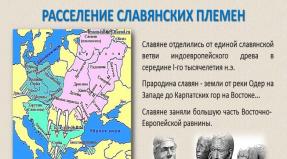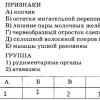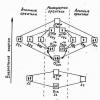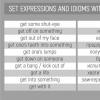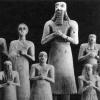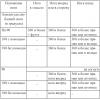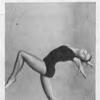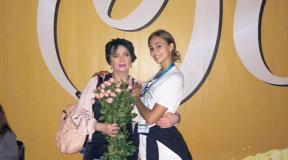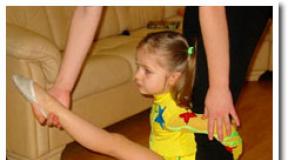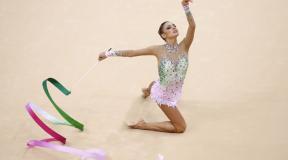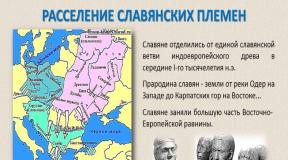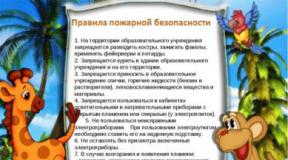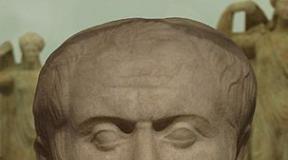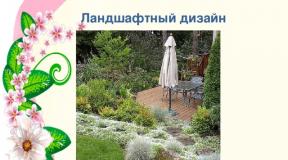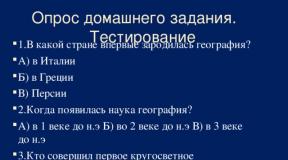Balances in gymnastics titles. We teach balance in rhythmic gymnastics. Characteristics of jumps in rhythmic gymnastics
Lesson type: educational
Method: group.
Lesson objectives:
Educational (improving exercise performance)
Wellness ( development of physical qualities: flexibility, dexterity, coordination of movements).
Educational ( cultivate discipline, patience, hard work, cultivate a culture of healthy lifestyle).
Venue: sports hall.
Time: 45 min.
Equipment: gymnastic bench, carpet, wall bars.
Introductory part: warm-up: various steps, jumps, hops, running.
Main part: general developmental exercises to strengthen the feet, back muscles, abs, legs, exercises to develop flexibility, splits, bridges, chest rolls, forward and backward swings, swings forward, to the side, back.
Final part: We praise children who have learned to make new elements, pronounce mistakes, and play (at the discretion of the children). Formation and exit from the hall.
Methods of teaching balances.
The prerequisites for learning balances are, first of all, physical readiness, which includes:
Developing strength and strengthening the muscles of the foot and lower leg.
Development of vestibular stability function.
Development of passive and active flexibility in the shoulder, hip joints, and spine.
Development of dynamic and static strength of the muscles of the legs, back and abdomen. Technical readiness.
Posture skills.
Basic skill of standing on high half-toes.
The ability to take a pose with the exact spatial position of body parts (“sense of pose”).
Psychological readiness.
It may consist in the formation of motivation for the need for preliminary physical training, in the formation of knowledge about the conditions for maintaining balance, about the criteria for the beauty of a pose and its significance as a means of expressiveness. Teaching balances should involve gradual complication, which consists of: sequential mastery of balances from basic skills to profiling elements and then to more complex forms;
in a gradual transition from lightweight conditions of implementation to basic ones:
At the support (face, side) on the entire foot;
At the support on the toe;
With temporary lowering of the support;
In the middle on the entire foot;
In order to maintain stable balance, you need to learn to eliminate unnecessary degrees of freedom and create a solid foundation by fixing the knee and foot. The easiest way to teach children to fix their knees and feet is with saddles:
Sitting on the floor, close your legs, straighten your knees, lift your heels off the floor and, with your shins tightly closed, try to spread your stretched toes. This position gives an idea of footwork.
In the saddle, spread your hips outward, touch the floor with your little fingers, bending and unbending, achieve complete tension and tight fixation.
Also lying on your back, hands up, behind your head. Close your socks and, pulling your knees, lift your heels off the floor - turn your hips outward until the little toes of your stretched feet touch the floor. Raise the leg by 45 0, 90 0, 135 0, then the amplitude increases to maximum. Do not lift your pelvis from the floor; perform the exercise alternately with your right and left legs. The free leg is pressed firmly to the floor.
Perform exercises while lying on your stomach.
The exercises are aimed at teaching children to fix the knee and shin, rotate the hip, without which it is not possible to achieve full amplitude when moving the leg to the side, forward, back. Learn to do this while maintaining a straight body position, paying attention to movements in the hip joints, controlling the amplitude.
When working on balances, gymnasts’ attention is initially directed to the pose necessary for the correct execution of the element. We mean posture in general and dynamic posture in particular. When mastering the elements of dynamic posture, it means selecting not one, but several poses for training.
Balance to the side at the support, without support and without the help of a hand.
(photo) Shaikhova Veronica,
 Luda
Luda

Lyuda, balance to the side at the support, with the help of a hand and without a hand, balance backwards (grab).




Chernova Daria (flexibility in the back is needed to do back balances, back balance). 

Current page: 3 (book has 8 pages total) [available reading passage: 2 pages]
Font:
100% +
QUESTIONS FOR SELF-CONTROL
1. What exercises are used to control the level of flexibility development?
2. What units exist to measure the level of development of flexibility?
3. What exercises are used to determine joint mobility?
4. What methods exist for determining jumping ability?
5. Describe the design of the goniometer.
6. What tests are used to determine speed?
7. How can you assess strength endurance?
8. What abilities are assessed by the Romberg test?
9. What qualitative methods exist for assessing range of motion?
10. What quantitative methods exist for assessing amplitudes of movements?
11. How is the quality of performing elements of difficulty without an apparatus assessed?
12. How is the duration of quality performance of flexibility exercises assessed?
13. What is the essence of the method of using symbolic notation?
14. Requirements for conducting pedagogical observations.
1. Belokopytova, Zh. A. Rhythmic gymnastics: curriculum for children and youth sports schools, specialized children and youth schools of the Olympic reserve, schools of higher sports excellence / Zh. A. Belokopytova, L. A. Karpenko, G. G. Romanova . – Kyiv: [b. i.], 1991. – 86 p.
2. Rhythmic gymnastics: a textbook for coaches, teachers and students of the Institute of Physical Culture / ed. L. A. Karpenko. – M.: Vseros. Federation of Artists gymnastics, 2003. – 381 p.
Additional
3. Vishnyakova, S. V. Improving the functional capabilities of female athletes at the initial stages of training in rhythmic gymnastics: textbook. – method. allowance / S. V. Vishnyakova, I. N. Solopov, B. M. Deputy. – Volgograd: [b. i.], 1998. – 54 p.
4. Karpenko, L. A. Methodology for assessing and developing physical abilities in rhythmic gymnastics practitioners: textbook / L. A. Karpenko, I. A. Viner, V. A. Sivitsky. – M.: [b. i.], 2007. – 77 p.
5. Kravchuk, A. I. Physical education of children of early and preschool age (scientific, methodological and organizational foundations of harmonious preschool, complex, physical education). At 3 hours. Parts 2, 3 / A. I. Kravchuk. – Novosibirsk: [b. i.], 1998. – 136 p.
6. Kuvshinnikova, S. A. System for assessing special physical fitness in rhythmic gymnastics: methodological recommendations for students, students of the faculties of advanced training and advanced training of the State Center for Physical Fitness and Physical Education. – M., 1991, – 31 p.
7. Lyakh, V. I. Tests in physical education of schoolchildren: a manual for teachers / V. I. Lyakh. – M.: AST, 1998. – 272 p.
8. Rules for rhythmic gymnastics: current standards for individual and group exercises: FIG, 2009–2012. – [B. m.: b. i.], 2009. – 128 p.
9. Pshenichnikova, G. N. Methodology for assessing the quality of performing elements at the stage of initial training in rhythmic gymnastics / G. N. Pshenichnikova, O. P. Vlasova // Current problems in the development of sports dancing, aerobics and fitness: collection of works of the All-Russian Scientific and Practical conference October 28–29, 2010 – 2010. – pp. 129–131.
CHAPTER 3. GENERAL CHARACTERISTICS AND FUNDAMENTALS OF TECHNIQUE OF ELEMENTS OF STRUCTURAL GROUPS difficulties WITHOUT SUBJECT at the stage of initial training
3.1. Characteristics of jumps in rhythmic gymnastics
Rhythmic gymnastics is a sport where the result of a performance is assessed subjectively, based on the quality of performance: the subject of assessment is exercise technique; criterion – perfection of execution in points. In this sport, classified as “artistic,” there is an increasingly acute need for objective methods for quantitative assessment of motor potential and the conditions for its best implementation. This is explained primarily by the increasing complexity of competitive programs.
Jumping is one of the most striking elements of composition in rhythmic gymnastics and at the same time one of the most difficult categories of movements, requiring excellent physical data and refined technical preparedness from gymnastics.
Due to their dynamism and emotional coloring, they are an excellent means of expression. The main task when performing a jump is to ensure that it is performed easily, gracefully, and emphasizes the character and expression of individual parts of the musical work. Coordination abilities in gymnastics and good physical preparation are one of the main prerequisites for successfully mastering jumps of varying difficulty.
The competitive rhythmic gymnastics program includes many jumping elements. Gymnasts are required not only to have good jumping ability, but also jumping endurance.
The large volume of jumping elements in the compositions makes them tempo, more dynamic and spectacular for perception. Naturally, increased demands are placed on performers, both in terms of technical and speed-strength preparedness.
Structural group "jumping"
Bounce– covering a distance in free flight by pushing off a support. This is the unsupported (flight) position of the gymnast.
The success of a jump is determined by speed-strength qualities, flexibility of the spinal column, mobility in the hip and ankle joints. With age, the level of speed-strength preparedness of young graces gradually increases and reaches a maximum by the age of 17. The most intensive growth of indicators was found in the period from 9 to 12 years.
Jumping elements constitute the main content of free apparatus exercises. For example, one of the main types of all-around is an exercise with a skipping rope, rich in a variety of jumps, the number of which in rhythmic gymnastics is almost unlimited. This is explained by the fact that there are quite a lot of factors that determine the shape of the jump, and the possibility of their combinations in one jump leads to the formation of an infinite number of different movements. For this reason, it is believed that a full classification of jumps is not yet possible today. However, for methodological and practical purposes, classifications that allow you to get a fairly complete picture of jumps are quite suitable.
The entire variety of jumps in the educational and methodological literature is classified according to the most characteristic features, taking as a basis the form-building actions, methods of repulsion and landing (Fig. 4, Table 5).
Rice. 4. Classification of jumps (according to T. S. Lisitskaya)
In accordance with the requirements of the competition rules for sports gymnastics, jumps are used in floor exercises (rhythmic gymnastics, sports aerobics, acrobatics, artistic gymnastics), which have a significant variety in their external form. If in rhythmic gymnastics jumps that make up difficulty groups must be performed with high amplitude both in the spinal column and hip joints, then in sports aerobics it is necessary to exclude large bends back (more than 45°) in accordance with the requirements of complying with the safety warnings of movements according to the competition rules. In this regard, in addition to the basic terminological name of the element, it is necessary to clarify the shaping actions, the method of repulsion and landing (Fig. 5). Thus, despite the variety of form-building actions, we can distinguish general phases of movements in jumps: preparatory, main and final actions. Jumps are performed from a standing position or from a running start.
Table 5. Classification of jumps by methods of take-off and landing


Therefore, in the preparatory actions, a run-up (acceleration phase), a pounce with a swing (or step) and a half-squat (depreciation) are performed, which precedes the take-off. The run-up, as a rule, is performed with stylized steps, leaps, and dance steps in accordance with the nature of the musical work.
When swinging, your arms should move back in the opposite direction. Next, a swing movement of the arms is performed in the direction of the jump, i.e. the swing is performed forward upward or in the direction of the jump for high-distance jumps. Proper use of the arms is important, since there is scientific evidence that about 30% of the height in jumps is provided by the swing of the free links (arms, legs).
Most of the achievement of height (up to 70%) of the flight occurs through rapid push-off with the legs or one leg. It must be remembered that a pre-stretched muscle contracts faster and more powerfully. Therefore, when taking off from a running start, it is recommended to make the last step longer, the swing leg remains behind, followed by extension of the pushing leg and swing of the other (with various options: bending, bending-unbending, straight swing, forward, to the side, forward to the side) repulsion is performed .
Such information must be taken into account when mastering or improving individual elements of jumps, and pay attention to the leading details of the technique.
It is necessary to use speed-strength training as a factor that complements the optimization of the conditions for mastering and improving motor actions associated with jumping elements.
Research and practical experience indicate that choreographic elements should be used as special means for developing the speed and strength qualities of gymnasts.
In particular, it must be taken into account that during push-off it is an error if the heels come off the floor before the depreciation phase ends. Therefore, the method of teaching the elements of repulsion in choreographic jumps is effective.
When teaching profile jumps to young “artists” (bending over, in a single ring, in a step, touching with the ring), the details of the technique indicated above should be taken into account. When mastering and consolidating the technique of performing exercises of structural subgroups, the main ones in the study are the basic and profiling elements. This is necessary to systematize training tools and ease their use in the educational and training process.
Basic elements are the initial ones in a structural subgroup that have characteristics or technical similarities with the main motor action. The run-up refers to the preparatory actions, the push is one of the phases of the main actions, since it is similar to many jumps performed with both a push of two and a push of one. Therefore, the basic exercises for a whole group of jumps are the push and landing (both when pushing with two and one leg). Therefore, it must be remembered that the effectiveness of training will be greater if you teach swinging the leg in different directions with quickly fixing the leg in different positions. But we should not forget another thing: a high swing of the leg during high-distance jumps is a mistake, since the jump is performed with a “roll”, “rocking chair”. Such execution of the jump leads to the impression of a lack of “freezing”, which negatively affects the assessment of its quality. Another important detail of the technique is the need for a sharp stop of the swing leg and arms, which makes it possible to impart movement to the underlying parts of the body.
Jumps that make up various difficulty groups according to the competition rules are studied sequentially: from basic to profiling and then to increasingly complex elements. The form of the jump can be performed in a static mode: on the floor, on the uneven bars, on the gymnastic wall, with the help of “wiring” along the movement, etc. Jumps with a push of one - a swing of the other should be taught when the gymnast has learned the initial simple choreographic exercises up to swings of 90 °. When jumping from a running start, you should teach how to swing your leg back - an open jump.
Thus, the simplest basic special jumps include jumps with a push of two and a push of one with a swing of the other in different directions. Connecting the correct movements of the arms and legs (swing movements) is an important aspect of learning to jump, since these actions relate to the main phase of jumping.
In order to master jumping faster and better, gymnasts must have a sufficient level of motor fitness, especially coordination abilities:
1) speed-strength qualities (jumping ability);
2) a sufficient level of passive flexibility (the ability to perform splits);
3) the speed of movement of the flywheels of the body;
4) landing in different ways (depreciation);
5) depreciation as a starting position for repulsion when performing elements of the subsequent jump, etc.
This technique turned out to be effective in teaching profiling jumps: bending over, changing legs forward and backward, touching jumps, etc. (Table 6).
Concluding this section, it is necessary to emphasize the following:
1. At the initial preparation stage, it is advisable to use the basic and profiling elements presented in Table 6.
2. The trainer selects from Table 6 the elements to be taught.
3. Focusing on the content of Figure 5, the trainer develops a training “strategy”, distributing special exercises in relation to the individual phases of the jumps being studied: methods of take-off and landing, forms of jumps in easier conditions, elements of “design”. At the same time, we should not forget about the need to teach young gymnasts to swing their legs in different directions.
Table 6. Basic and profiling elements of the “jumps” structural group


When teaching elements of other structural groups, difficulties without an object (balances, turns, tilts) are also recommended to be studied sequentially from basic to profiling (Tables 8, 10, 11).
Table 6 shows various options for take-off and landing in jumps with a straight body position, which are “transformed” into amplitude jumps in profiling elements.
It is recommended to test the jump form as a model in a static mode: on the floor, on the uneven bars, against the gymnastic wall, using “guide” movement. Based on the above, we can conclude that in order to master options for beautifully performing jumps, a gymnast must have a set of qualities: elasticity and strength of the leg muscles (foot, lower leg, thigh), optimal speed of muscle contractions; master the technique of basic movements in various phases of jumps; have good flexibility for the correct “reference” execution of the jump according to the requirements of the competition rules. In addition, we must not forget about the importance of the function of the vestibular analyzer for orientation in space.

3.2. Characteristics of balances in rhythmic gymnastics
Equilibrium- this is a relatively stationary position of the gymnast’s body parts, in which she stands on one or two legs. According to the rules of rhythmic gymnastics competitions, the structural difficulty group of “balance” includes static elements that are performed with a large amplitude of movements in various positions of body parts. The elements of balance received their terminological name based on the position of the body relative to the vertical: vertical, anterior, lateral, posterior. Due to the wide variety of types of equilibria, their name is specified in each individual case (Fig. 6).
To determine the main sign of balance, two words are enough, and the positions of the arms and free leg are indicated additionally. For example, balance on the right, bending the left back (“attitude”); the element is borrowed from classical choreography. Here are the basic terms necessary for communication between specialists and athletes at the initial training stage:
Tilt balance– the body is tilted forward and downward by 45, hands near the floor.
Lateral balance– the performer is positioned sideways to the support, the same hand up, the other behind the back.
Equilibrium of the same name– the arm of the same name as the supporting leg is raised forward upward, the other back.
Opposite equilibrium. A different hand position is indicated. Posterior balance involves the performer turning his back to the support, arms to the sides. A different hand position is indicated.
Frontal balance– one leg is directed to the side or higher, arms to the sides.
Frontal balance with grip– the leg directed upward is held with the same hand, the other hand is directed upward outward.

Rice. 6. Scheme of options for possible execution of balances in various support positions (according to T. S. Lisitskaya)
High balance (vertical)– the torso is in a vertical position (or close to it), the free leg is laid back, the same arm is to the side, the other is forward or up. It is performed on the toes, with the free leg bent and a different position of the arms, as indicated additionally.
Equilibrium in a half ring – the leg bends back at the level of the head or above, but does not touch the head, arms up outward. A different hand position is indicated.
Balance by the ring – the leg bent back touches the head with the toe. Usually performed with the hand grasping the ankle joint above the head.
Balance on the knee performed with knee support.
Back balance on the knee- similar to the previous one, but with your back to the support.
Cross balance– performed by moving the unsupported leg to the side and bending forward; The hand of the same name as the supporting leg is directed to the side, the other hand is forward. Twine balance – the leg is pulled back while simultaneously bending forward and grabbing.
Most balances in rhythmic gymnastics are performed on the toes. Variants of these equilibria are presented in Table 7. It also presents the amplitudes of movement of the body parts. In practical activities, the use of both classifications is acceptable, since at the current level of development of rhythmic gymnastics, coaches have at their disposal detailed contourograms of movements in accordance with their difficulty according to the competition rules.
Maintaining balance is easier with technically correct execution of movements. Among the private recommendations, it is necessary to recall some of them. While maintaining balance while standing on your feet, it is recommended to fix your gaze strictly horizontally on any object. It is useful to train balance with your eyes closed, because this sharpens the muscle-joint sense and the work of the vestibular analyzer. In each specific type of activity, depending on its specifics, one or another analyzer is the leading one.
There is a relationship between people’s physical fitness and balance function indicators. You should pay attention to the correct functioning of the muscles when performing balances (Fig. 7). So, when performing forward balance, the trapezius muscle of the left supporting side and the latissimus dorsi muscle of the right free side are most tense. When performing posterior balance, the greatest tension is on the torso flexors of the right free side. The working posture of gymnastics when performing static balances on one leg is due to the asymmetrical static tension of the paired muscles of the torso. Therefore, a prerequisite for training is that gymnasts perform exercises on both the right and left legs. Technically correct would be to perform a front balance with the leg moving back, while simultaneously straining the back, slightly raising the head and moving the shoulders back. According to the rules of the competition, a mistake is when the shoulders and legs are lowered down, i.e., the continuous arc-shaped line that should be formed by an arched back with a leg pulled back is broken. To perform posterior balance, you should not start by tilting your head back, as is sometimes observed in practice.

Rice. 7. Asymmetrical muscle work when performing balances (according to the results of electromyographic studies)
Table 7. Classification of balances on one leg

Table 8. Basic and profiling elements of the “equilibrium” structural group


We have developed basic and profiling elements (Table 8), which make it possible to lay the foundation for a strong motor skill in performing elements at relatively small amplitudes.
To increase active flexibility, it is necessary to combine it with the development of strength, because in order to raise the leg to the required height while maintaining the posture in a certain position, a complex of manifestations of psychomotor qualities is necessary: flexibility, strength, static endurance, vestibular stability. The quality of balance performance largely depends on how the gymnast is able to assess the position of the body parts in space.
When fatigued, the spatial assessment of body parts deteriorates and the balance function is disrupted. This is due to the fact that, under the influence of gravity, a moment of force arises that tends to bring the body out of balance, and a tired muscle is not able to counteract this force in space. Learning exercises at a support makes it easier to maintain balance. Experts know that the quality of balance depends on many factors: the correct relative position of the body parts in space (torso and legs); static endurance in this position and the ability to maintain balance with eyes closed. Balances are better and easier to master if you have good general physical fitness. Therefore, during the initial stages of training, special attention should be paid to exercises on strength, flexibility, and static endurance. You need to try to strengthen evenly the main muscle groups that perform different functions when performing balance: strengthening, holding, fixing. So, when balancing on one with a tilt both forward and backward, the moments of gravity for the torso and free leg in all joints are greatest, the tension of the hip extensor muscles in the hip joint of the free leg is high, which resist not only the gravity of the entire leg, but and resistance of the hip flexors and ligaments preventing extension. When performing balance by athletes with poorly developed mobility in the joints, the holding work of the muscles associated with the moments and forces of gravity of the body parts is also supplemented by the resistance of the antagonist muscles. The use of the scheme of motor actions presented in Figure 8 will help the coach in studying “smaller” movements of individual parts of the body, which will subsequently create a solid foundation for the “school of movements.”

The diagram of motor actions presented in Figure 8 by body parts, taking into account amplitudes, shows the main blocks of actions that can be taken as a guide when choosing special exercises for their sequential application when studying exercises of the “balance” structural group. Table 8 presents the basic and profiling elements for the initial training stage. Based on the information indicated in the tables and diagram, you can also make a choice of exercises based on the degree of complexity of the relative position of body parts in space, the amplitudes of the exercises, the nature of the support and taking into account the age characteristics of the participants.
Balance refers to such applied physical abilities of our body, the inability to use which makes a person awkward, angular, and fearful. Balance exercises improve the vestibular apparatus, develop skills and abilities to maintain stability in various body positions, movements and unexpected stops. To do this, a person must have a certain strength and be able to make appropriate compensatory movements in order to correctly maintain the center of gravity of the body above the support area. In this case, the body is in a stable position (static equilibrium). With dynamic balance, this position is constantly disrupted and restored by active muscle work. In this case, the correct position of the head and general posture of a person is important, as well as the ability to move smoothly; without sharp jolts, change the relative position of body parts. Gymnasts learn all this by doing balance exercises.
Among the well-known balance exercises in women's gymnastics, various stands on a reduced area of support, sharp stops after movements, movements with a complicated position of the body and simple turns are used.
Balance exercises are usually divided into static and dynamic.
When performing static exercises, it is necessary to evenly distribute the weight over the entire foot, especially all the toes, avoiding relaxation of the muscles of the legs and torso, and correctly distribute muscle efforts. The latter becomes decisive when performing dynamic balance exercises, such as stopping on the toes after walking, running, jumping, etc. Standing on the toes (toes) can be taken technically in two different ways: stepping on the toe (toes) of a straight leg or rising on the toe(s) are springy, i.e. through a half-squat on the entire foot. The same applies to the technique of making turns. Twists are a form of dynamic balance exercise. They can be simple or very complex in technique. The latter are not widely used in women's gymnastics, as they require long learning and a high level of physical qualities. Nevertheless, the balance function is successfully improved by the entire system of exercises in women's gymnastics. This is facilitated by the combinations of walking, running, spring movements, bouncing, jumping and turning that are characteristic of women's gymnastics. In classes they relate to each other and to the dance steps in different ways. Swings, especially swings, as well as turns during jumps, provide a good load for the vestibular apparatus.
Sample exercises
1. Walking along a marked line, on a gymnastic bench, climbing on a gymnastic wall.
2. Fast and deep squats followed by a jump up.
3. Stand on one leg (on the entire foot), the other in various positions. The same, with various movements of the free leg and arms (Fig. 27). The same, in combination with various forms of movement.
4. Stand on your toes, arms in different positions. The same after running, spring movements, squats and jumping. The same, with turns of the torso and head, with tilting and changing the position of the torso (Fig. 28, a b).
5. Stand on the toes of one leg (stepping on the toes and standing across the entire foot), the other leg and arms in various positions. The same, with various movements of the free leg and changes in the position of the torso and arms. The same, take a running start and hold the accepted position (Fig. 29).

6. Vertical balance. Same thing, from a running start. The same, through a half squat on one leg. The same, on the toe, standing across the entire foot and stepping on the toe.
7. Front balance. Same thing, from a running start. The same, from a deep squat. Repeat at pace.
8. Round half squat. Same thing, from a running start. Same thing, from a jump. The same, on one leg, the other in different positions.
9. Springing, transferring weight forward and backward, swing your arms forward and upward to stand on your toes.
J 1.00 et plus |
||||||||||
14. Vertical jumps (with different leg positions). Criterion: rotation only |
||||||||||
24. foot forward, |
with a turn |
with 360° rotation |
Vertical. jump with foot in |
|||||||
or to the side |
180° in flight |
horizon. position with ½ |
||||||||
or back |
rotation of the whole body; without |
|||||||||
stops, from ½ turn |
||||||||||
torso, padding |
||||||||||
push |
||||||||||
In a group with |
15. Tuck jumps |
|||||||||||||
25. In a group with |
||||||||||||||
180° rotation |
360° rotation |
|||||||||||||
16. Vertical jumps with a turn |
||||||||||||||
26. With a twist |
||||||||||||||
17. Special Case: "Bedouin Leap" |
||||||||||||||
27 “Bedouin” |
in horizontal |
in an inclined plane |
||||||||||||
plane |
||||||||||||||

SECOND SECTION – INDIVIDUAL EXERCISES
4. EQUILIBRIUM
4.1 General provisions.
4.1.1. Basic characteristics:
balance difficulties must be performed on half toes or on the knee and have a clearly defined and fixed form (without additional movements of the free leg or supporting foot during the difficulty)
4.1.2. The mastery of an object should be considered from the moment when the equilibrium position is fixed until the moment when the position begins to change.
4.1.3. In the exercise it is possible to perform one balance - “turlyan”. All “turns” should be started only after the position of difficulty has been fixed, and also
no more than ¼ rotation with each movement. The rotation gained from one impulse will cancel the difficulty value.
During difficulties with the turnbuckle, the body cannot make jumps (upward movement
And down the torso and shoulders). This incorrect technique will cancel the value of the “turlyan” (+ execution errors).
4.1.4. Difficulty changing shape - free and continuous movement of the free
legs through several directions and/or axes of the gymnast’s body, (without taking support when changing form) – represent a special category
complex difficulties. The level of difficulty is calculated by summing the values of the first and second balances + 0.10 for connecting balances without lowering onto the heel in a position on the half-toe and + 0.10 for a possible rotation of the body when changing the form of balance. In this case, you need to show a rotation symbol above the symbol
second equilibrium. Example: ( |
) F (0.60) |
4.1.5. “Fouette” balance: () at least 3 times taking the support, with fixation on the half-toes of each form of balance, with a change in level (or without), with a change in the position of the free leg (or without), always with a change in the direction of the gymnast (at least once) . Initial balance value +0.50
4.1.6. Balance: () in a split with a leg circle: the movement of the leg must be non-stop, sequential, passing through three splits, with assistance in the final position.
4.1.7. The FIG Technical Committee for Rhythmic Gymnastics does not encourage the performance of “turns” and balances on the knee.

SECOND SECTION – INDIVIDUAL EXERCISES
Equilibrium – table of difficulties ()
1. With torso tilt
2. Bend your torso back
2.1.Free leg forward or to the side
3. In a horizontal position forward or to the side
Forward "Turlyan" (180°) "Turlyan" (360°) -- to the side
4. Split forward or to the side
Forward with help |
Forward without |
Forward or in |
Forward or in |
Forward or in |
Forward or in |
||||
to the side using |
side of the "Turlyans" |
side of the "Turlyans" |
side of the "Turlyans" |
side of the "Turlyans" |
|||||
To the side without |
(180°) using |
(180°) without assistance |
(360°) using |
(360°) without assistance |
|||||

SECOND SECTION – INDIVIDUAL EXERCISES
J 1.00 and above |
|||||||||||||||||
3. Free |
leg back |
||||||||||||||||
5 . Arabesque or |
"turlyan" (180°) |
Attitude (or |
"turlyan" (360°) |
||||||||||||||
arabesque) with slant |
|||||||||||||||||
torso back |
|||||||||||||||||
6. Back split or |
ring using |
by using |
"turlyan" (180°) |
"turlyan" (360°) |
|||||||||||||
7. Leg back higher |
head or ring without |
Back split |
"turlyan" (180°) |
"turlyan" (360°) |
|||||||||||||

SECOND SECTION – INDIVIDUAL EXERCISES
front |
|||
8. Front balance |
|||
equilibrium |
|||
9. Front balance with leg up using
10. Lateral balance
J 1.00 and above |
||||||||||
4. Torso in a horizontal position (balance) |
||||||||||
Front |
front |
Front |
forward balance |
forward balance |
||||||
equilibrium |
balance with |
equilibrium |
with twine |
with twine "Turlyan" |
||||||
"turlyan" (180°) |
twine, |
"turlyan" (360°) |
"turlyan" (180°) |
|||||||
free leg |
||||||||||
straightened or |
||||||||||
bent into a ring |
||||||||||
front |
front |
||||||
equilibrium. leg-split |
equilibrium. twine with |
||||||
by using |
with the help of "Turlyans" |
||||||
front |
"turlyan" (180°) |
||||||
balance (splits) |
|||||||
by using) |
|||||||
lateral balance |
|||||||
equilibrium |
equilibrium |
"turlyan" (360°) |
|||||
"Turlyan" (180°) |
lateral balance |
||||||
with twine without |
|||||||
balance with |
|||||||
twine without |
"Turlyan" (180°) |
||||||

SECOND SECTION – INDIVIDUAL EXERCISES
11. Lateral balance with leg up using
12. Posterior balance
4. Torso in |
horizontal position (equilibrium) |
(continuation) |
||||
equilibrium |
balance leg |
|||||
5. Bent supporting leg |
||||||
13 . Leg in a horizontal position |
"Cossack" forward |
Gradual |
"turlyan" (180°) |
"turlyan" (360°) |
||||||||||
forward or to the side |
"Cossack" in |
bending |
||||||||||||
supporting leg |
||||||||||||||
14 . Leg up forward |
Gradual |
"Turlyan" (180°) |
"Turlyan"" |
|||||||||||
By using |
bending |
|||||||||||||
supporting leg |
||||||||||||||

SECOND SECTION – INDIVIDUAL EXERCISES
J 1.00 and above |
|||||||||||||
15. Leg up forward without assistance |
without help |
Gradual |
"turlyan" (180°) |
"turlyan" (360°) |
|||||||||
bending |
|||||||||||||
supporting leg |
|||||||||||||
"Cossack" back |
"turlyan" (360°) |
|||||||||||||||||||||||||||||||||||||||||||||||||||||||||||||||||||||||||||||||||||||||||||||||||||||||||||||||||||||||||||||||||||||||||||||||||||||
16. In horizontal |
position |
Gradual |
"turlyan" (180°) |
|||||||||||||||||||||||||||||||||||||||||||||||||||||||||||||||||||||||||||||||||||||||||||||||||||||||||||||||||||||||||||||||||||||||||||||||||||
"Cossack" attitude |
bending the supporting |
|||||||||||||||||||||||||||||||||||||||||||||||||||||||||||||||||||||||||||||||||||||||||||||||||||||||||||||||||||||||||||||||||||||||||||||||||||||
SECOND SECTION – INDIVIDUAL EXERCISES
18. forward or to the side Forward or sideways in a horizontal position
Front equilibrium -- front balance with
SECOND SECTION – INDIVIDUAL EXERCISES 5. TURNING 5.1 General provisions. 5.1.1. Basic characteristics: performed on half toes (with a raised heel); have a clearly defined amplitude and a fixed shape until the end of rotation 5.1.2. The base rotation of any turning difficulty is always 360 0 . Each additional 3600 rotation (without taking a support) increases the difficulty level by the base value of that turn (for both isolated and shape-change turns). A little bouncing or resting on your heel while rotating breaks up the difficulty. 5.1.3. In the case of an incomplete turn compared to what was stated on the card, the turn is scored based on the number of rotations performed (this criterion also applies to fouetté turns). 5.1.4. The turn can end with a lift of the torso and leg, which gives it greater precision at the end of the difficulty. 5.1.5. A series of identical turns is allowed (maximum 3), which are performed one after another without a break and only with taking support. Each turn of the series counts as a separate difficulty. Exception: a series of identical fouetté turns (2, 3 or more) is counted as one difficulty. 5.1.6. Cossack twist: initial impulse from the floor with the help of the hand/hands is allowed. The degree of rotation is counted starting from the moment when the hand/hands do not touch the floor. The position is considered correct even if the gymnast “sits” on the supporting heel - the heel is raised above the floor. 5.1.7. Turn with gradual bending of the supporting leg: the transition from the form of a straightened supporting leg to the form of a bent supporting leg should be slow and clearly gradual. 5.1.8. Rotations with shape changes represent a separate category in which the transition from one form to another is performed without taking support. If the gymnast drops her heel to the floor, the turn is annulled. Each form that makes up the rotation should generally have a rotation of 360°. The transition of the free leg from one form to another is carried out arbitrarily, without delay, in the simplest possible way. 5.1.9. The value of a shape change turn is as follows: a turn including 2 forms: to the value of the 1st form (base 3600) + value of the 2nd form (base 3600) + 0.10 for connecting turns without taking support; rotation including 3 forms: to the value of the 1st form (base 3600) + value of the 2nd form (base 3600) + value of the 3rd form + 0.10 + 0.10 for two connections, etc. 5.1.10. The value of fouette turns is calculated as follows: base value (3600) + 0.20 for each additional rotation.
| ||||||||||||||||||||||||||||||||||||||||||||||||||||||||||||||||||||||||||||||||||||||||||||||||||||||||||||||||||||||||||||||||||||||||||||||||||||||



